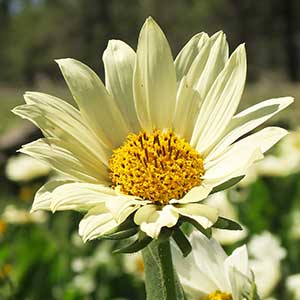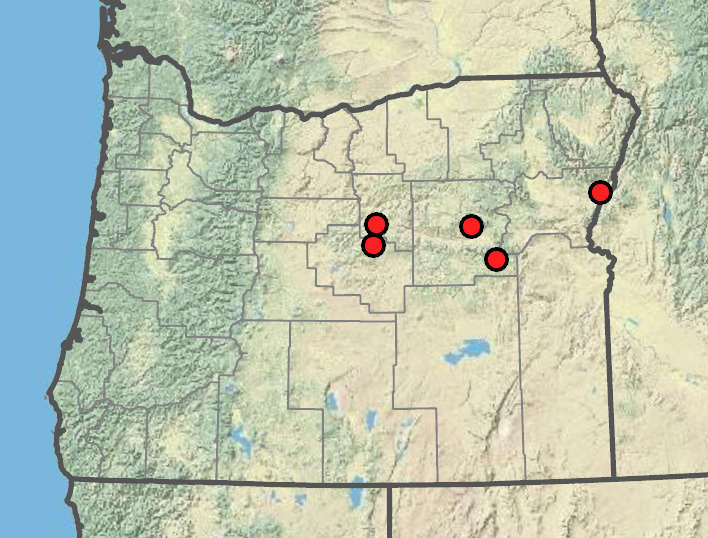Wyethia x cusickii
Wyethia mollis
hybrid mule's ears
woolly mule's ears
erect, 32–45 cm, sparsely to very sparsely villous-hirsute.
erect, 30–72 cm.
lanceolate to elliptic to ovate, 21–26 × 6.5–11.5 cm, generally < 3 × as long as wide, bases sometimes decurrent;
margins entire or with small teeth;
surfaces glabrous but generally sparsely hirsute on midribs and margins;
petioles 2–13 cm. Cauline leaves lanceolate to oblong, 6–18 × 2–6 cm;
petioles 0–4 cm.
ovate-lanceolate to obovate-oblanceolate, 18–32.5 × 5.5–15.3 cm, sometimes ± decurrent;
margins entire;
surfaces tomentose, becoming glabrate;
petioles 10.5–19 cm.
ovate-lanceolate to obovate-oblanceolate, 5–21 × 2–7.5 cm;
petioles 0.5–8.6 cm.
terminal heads 1, occasionally with 1–4 reduced; axillary heads;
peduncles up to 1.5 cm.
terminal heads 1; larger; axillary heads 0–3, sometimes reduced;
peduncles 1.9–5 cm.
terminal 30–45 × 13–15 mm; axillary ~12 × 10 mm.
terminal 17–30 × 10–20 mm; axillary 15–25 × 10–15 mm.
~15, light yellow;
rays 35–45 × 8–10 mm.
larger heads 8–13; smaller heads 7–10, yellow;
rays 20–35 × 6–9 mm.
~9 mm.
linear to lanceolate, 17–28 × 3–6 mm;
surfaces ciliate.
ovate-lanceolate to lanceolate, 17–34 × 5–10 mm;
surfaces tomentose, not ciliate.
7–11 × 1–2 mm, strigillose apically;
pappus scales lanceolate; crowns 0.3–1 mm.
9–12 × 1.5–2 mm, loosely villous;
pappus scales subulate, 1–3, 2–3 mm, ciliate; crowns 0.3–1 mm.
15–18 mm.
Wyethia x cusickii
Wyethia mollis
Open, grassy areas. Flowering May–Jun. 800–1700 m. BW, Lava. ID, WA. Native.
Wyethia × cusickii is the hybrid between W. amplexicaulis and W. helianthoides and can be expected wherever their ranges overlap. It ranges from something that looks very much like W. amplexicaulis, but with ciliate phyllaries, to something that looks much like W. helianthoides but is mostly glabrous.
Grassy areas. Flowering Jun–Aug. 1300–2000 m. BR, ECas. CA, NV. Native.
“Mollis” means soft, in reference to the hairs.
Abigail (Abby) Moore
Abigail (Abby) Moore





